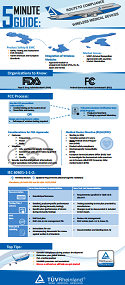Any wireless device presents challenges when it comes to compliance. But what about a medical wireless device? Here’s where things get even more complicated. Aside from the safety of the medical device, manufacturers must also be concerned with whether or not the device is secure – from any number of cyber threats.
Designing for Compliance
Let’s face it – a company’s main objective is to make money. To that end, manufacturers want a market-ready device as quickly as possible. Unfortunately, it’s never that easy! What most manufacturers fail to realize is that they have to consider compliance during the design and development of their device. They must understand the requirements and regulations for their device and the markets they want to sell into, as well as the cost to their business if they don’t. Recognizing compliance early on in the design process can help reduce production delays, saving time and money.
Preparing for the Future
One word for you: Telemedicine. It’s not just that we are exchanging wires and cables for wireless technologies in healthcare settings. That trend will continue to grow at a rapid rate. We have probably all witnessed diagnostics and monitoring from a wireless device. But have you considered new-to-you functions like wellness and clinical applications? That’s where telemedicine comes in.
Within the next 10 years patients will use devices equipped with sensors and cameras to monitor their own health stats and send them electronically to their caregivers. Video consultations and health apps will become the norm. In fact, it’s already happening! There will come a time when doctors make decisions through technology. Heck, there are already operating rooms using robotic technologies. So you see, it’s not just about traditional product safety. Cyber hacks are real. They happen every day. They happen in the healthcare industry. Every day. You can appreciate why data storage and device security (communications to and from), along with product safety must be considered.
Time is Money and Other Clichés that are True
With increased competition and rapid technology development, medical device manufacturers must get compliance right. Imagine two companies developing similar devices. One brought in a testing and certification partner in during the design phase, working to understand the requirements and regulations for compliance. The other designed a device that failed regulatory approvals and cause a 6-month delay in getting their product to market. Plus an unforeseen cost to redesign their product. Penny-wise, pound foolish….
The Must Knows for Compliance
There are two major bodies that regulate medical devices in the US: The FCC and the FDA. The FDA is primarily responsible for “clearing” a device after reviewing a 510K – also known as a premarket notification. Most companies are familiar with the FDA and should keep up-to-date with their recommendations for medical devices.
 |
| Download full infographic |
The FCC addresses the use of low-power radios for wireless communications. The FCC develops and executes rules for products based on the wireless technology being used. The FDA typically expects a device to comply with the FCC before it complying with FDA regulations. The FCC’s main requirements for this product type are presented in Title 47 of the Code of Federal Regulations. The infographic to the right details some of the considerations for FDA Approvals, along with updates to the Medical Device Directive (MDD) and EMC 4th Edition.
In Europe, medical products are covered under the Medical Device Directive. However, the Medical Device Regulation (MDR) is expected to come into effect in the very near future. Further, Directive 2014/53/EC for Radio Equipment, in effect since June 13, 2016, is required for devices using wireless components.
Cybersecurity also plays a role, with pending legislation likely in the US and Europe very soon.
Go To Market Strategy
It’s clear the market potential for wireless medical devices is huge. But the complexities of compliance present a real challenge to medical device manufacturers. Bringing in a compliance partner in the early stages of design can save companies time, money and headaches. In such a competitive market, getting it right from the beginning can offer the competitive edge needed to get your product to market on time and on budget!
For more information on our wireless testing solutions, please visit our website or contact us to speak to one of our experts.



